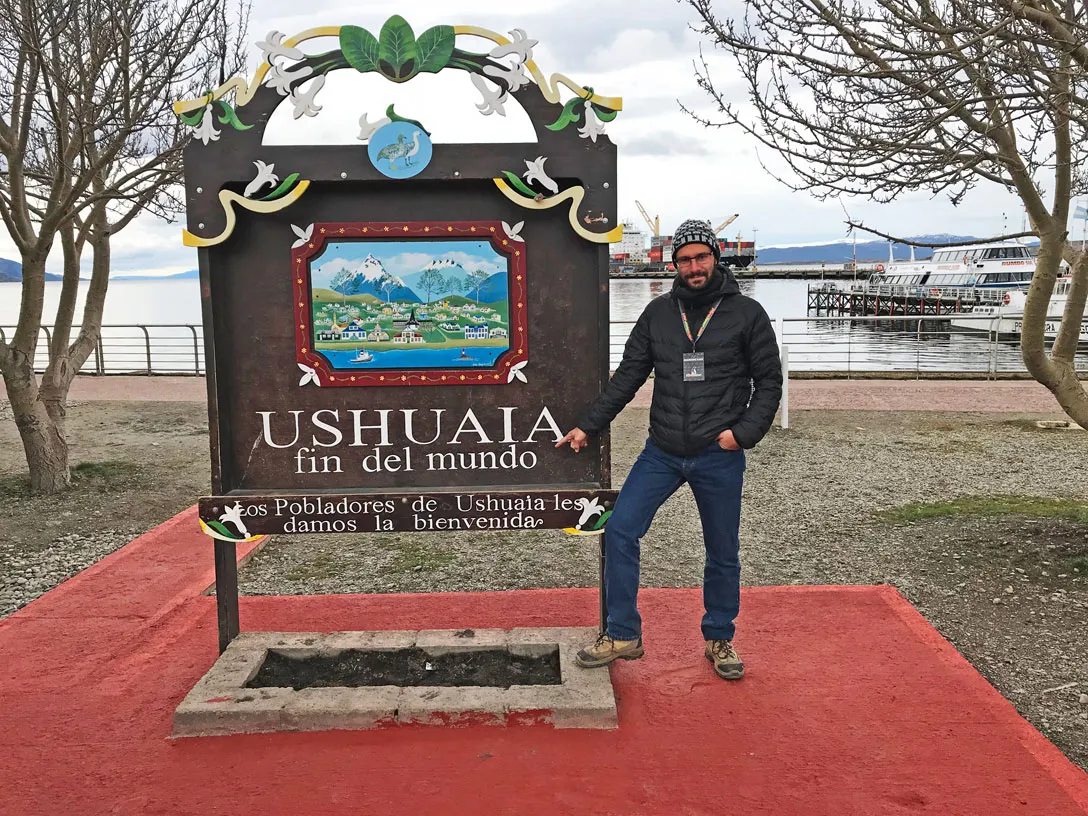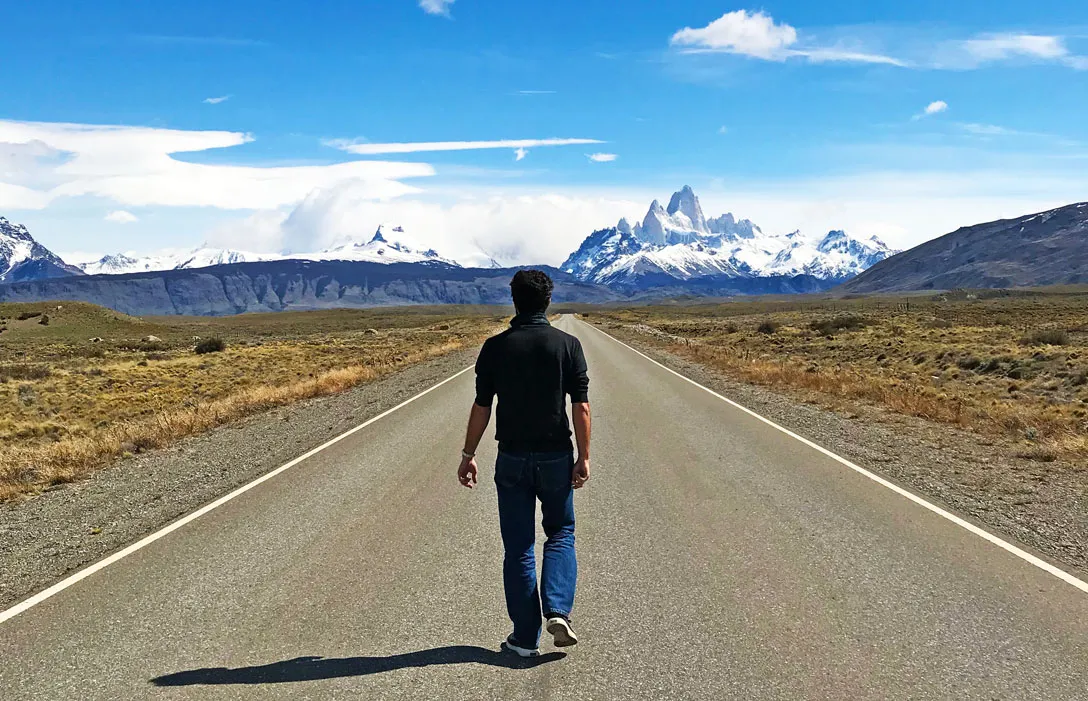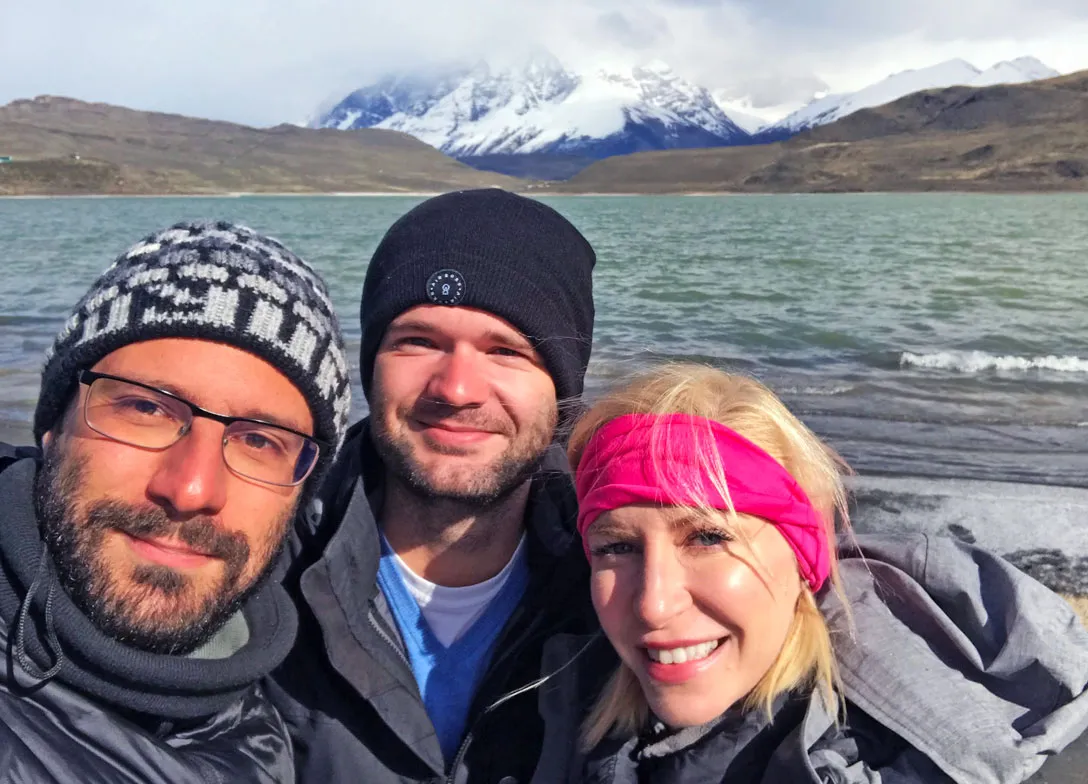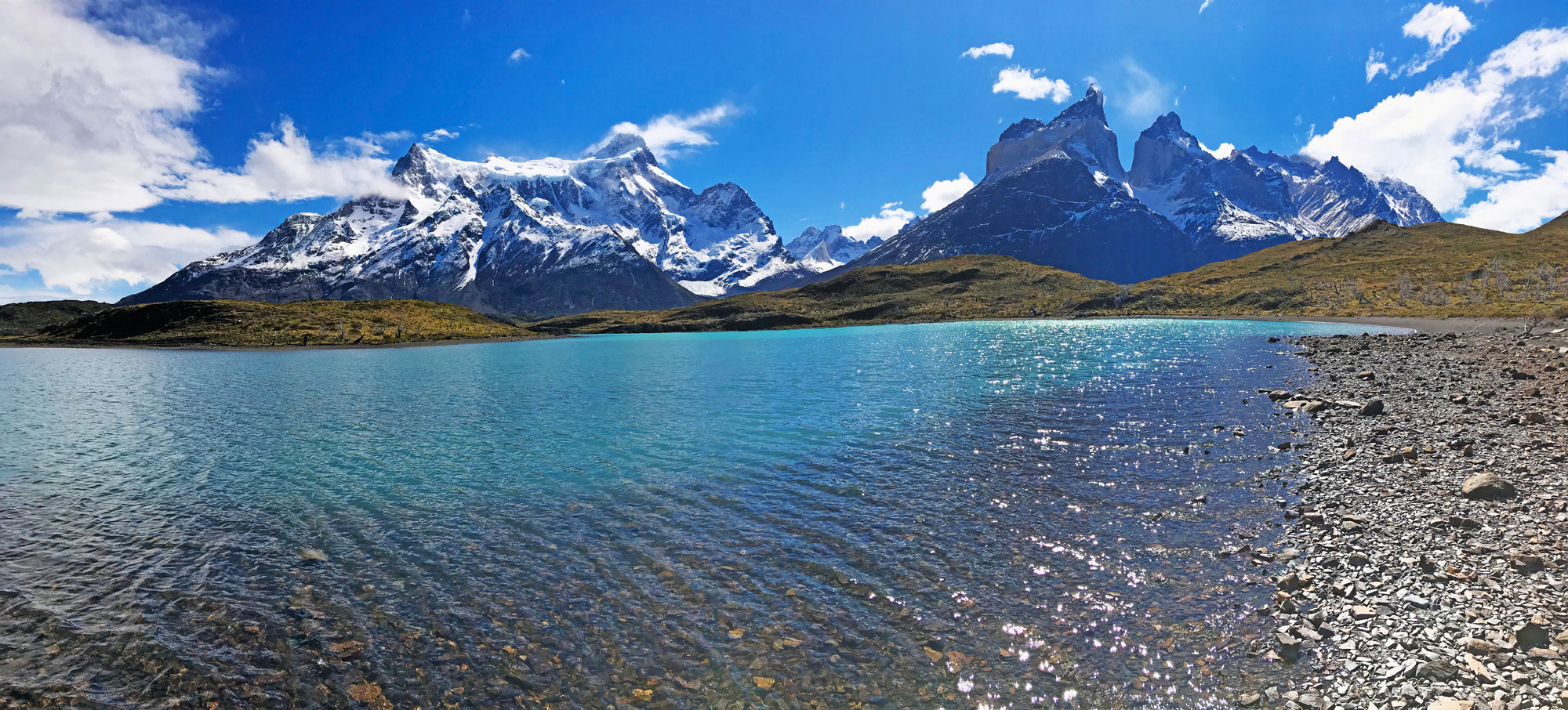If I have to describe Patagonia in two words, I would say: blue and windy. Blue, because lakes, lagoons and glaciers are so deeply blue and breathtaking. Windy because, even if it’s not as cold as you might expect, the famous Patagonian winds hit you so strongly!
There are many things to see in Patagonia and many ways to visit it. What I propose here is the itinerary I followed during my one-week trip there with my friends Chris and Ashley, trying to hit all the main places. Feel free to follow it exactly or just for taking inspiration.
Day 1: Tierra del Fuego National Park, Ushuaia
Ushuaia is also called Ciudad de fin del mundo (End of the World City) and with a reason: it’s the most southern city in the world and it’s a must if you go to Patagonia.

Ushuaia, Ciudad de fin del mundo
If you take the flight that leaves at 4 am from Buenos Aires (yes, 4 am…) and arrives at 8.30 am to Ushuaia, maybe it could be a bit painful, but you have the entire day available.
After leaving your baggage at the hotel (we stayed at the Hotel Antartida Argentina), reach the bus station and buy a transfer to the Tierra del Fuego National Park. There are a couple of options: the bus can leave you at the train station, where you take the Tren del fin del mundo, a steam train that brings you into the park. From there, you are supposed to be able to take various walking paths, but when we went in October the only option was going back again by train and take the bus to the other side of the park, where there were the only two paths available.
We opted for skipping the train (which costs 1000 pesos!) and taking the bus directly to the park, as the price (700 pesos) is the same whether stopping at the station or not. The bus leaves you at the beginning of the two trails. You can start by taking the one to the Lapataia Bay: it’s an easy one-hour roundtrip walk with a mirador at the end.

Lapataia Bay at the end of the first path
The second trail leads you to the bus picking point, passing by the Laguna Negra. You can already take the bus back, order something at the restaurant or follow the other one-hour path back and forward to Lago Roca.
I have to admit that I expected more from the park. It wasn’t really impressive, maybe also because the main paths were closed.
Day 2: Isla Martillo
The main reason why we went to Ushuaia is for the “walk with penguins” tour on Isla Martillo! The only agency that does it is Piratour, while the others just take you close to the island by boat, but they don’t allow you to actually walk on the island. Be sure to book it a few weeks before.
The tour starts at 10 am from the touristic port of Ushuaia: you take a boat that navigates the Beagle Channel, stopping by an island with cormorants, another one with sea lions, an island with a lighthouse and stopping in the end to the Estancia Harberton. Here you have lunch at the restaurant and you take turns in order to get another small boat that will bring you to Isla Martillo.

The lighthouse at the end of the world
This island has been chosen as home by many Magellanic and Gentoo penguins, that come here to lay eggs after the winter season. The guide leads you on an hour tour around the island and you see hundreds of penguins. Of course, you cannot touch or hug them (I know, it’s difficult to resist!), having to keep a 3 meters distance. But they are totally careless and it can happen that they are walking towards you and you have to move aside, in order not to be on their way.

A couple of cute lovely Magellanic penguins
You see couples of penguins spying you from holes in the ground, others slowly wandering around with some grass in the beak or just standing bored, others sleeping or laying on the ground in order to protect themselves from the strong wind. They are so fluffy and goofy that is impossible not to fall in love with them!

Communicating with a penguin!
After coming back to the Estancia, you spend another hour in the Acatushún museum, where you learn about all the fishes, dolphins and whales that inhabit the surrounding waters, being able to see all their skeletons.
You are back in town at around 7 pm. I recommend having an early dinner at the best restaurant in town: El Viejo Marino, famous for its centolla, a huge king crab that you can see still alive at the entrance. Be sure to go straight away as soon as it opens at 7 pm, because otherwise it will be impossible to find a table available.
Day 3: traveling
Today is a day of travel! Take the flight that leaves from Ushuaia at 10.45 am and lands at 12 am at El Calafate.
From there, rent a car at the airport (reserve it online before, of course! We rented it from Hertz). Make sure to ask for the immigration papers for crossing the Chilean border: you have to reach the Hertz agency in the city in order to obtain them. Since you are here, have a good lunch and you are ready to go!
Take the route 40 in direction to Torres del Paine, but be sure to pass by La Esperanza, for two reason: firstly because there is the only gas station in the area apart from the one in El Calafate; secondly because the more direct itinerary Google suggests is not recommended as we have been told the road is in bad conditions.

Roadtripping
The entire journey is a 4 hours drive, including stops: it should take about 1,5 hours to reach La Esperanza (make the full tank, even if you haven’t used too much gas, just in case) and 1,5 hours more to get to the Argentinian custom on a road with many holes. After passing also the Chilean custom, you still have a few kilometers left on an unpaved road, before reaching Estancia Dos Elianas, the place we booked for the first night here. It’s quite expensive ($130 for a night!), but there are not really a lot of options in this area and nothing is cheap.
The accommodation is a nice wooden cabin with a wood stove in the middle of nowhere, but it’s located 10 minutes driving from Torres del Paine, a very small town with just a couple of cafes and grocery stores where you can buy your dinner. Keep in mind that there is no wifi and no 3G network at all. Moreover, almost nobody accepts credit card there, so you will need Chilean pesos or US dollars.
If you are lucky and there are no clouds, you will be rewarded with an amazing starry sky!
Day 4: Torres del Paine National Park
Get up early, have a big breakfast and leave not later than 9.30 am. After almost one hour driving you reach the Laguna Amarga, while entering the park and paying the entrance fee ($35 each!). The view is stunning and you will not regret: behind a very green wind-ruffled lagoon, the Towers rise in their majesty. Changes are that you will not be able to see the top if it’s cloudy, but it’s still worth it.
Keep following the road and drive around the mountains, being able to see the other side from many lookouts that overlook the Lago Nordenskjöld, probably the most turquoise lake you will see in your life. In about half an hour you reach the turn to the Salto Grande, very well marked. Park at the estacionamento and start to walk.
After about 20 minutes, you reach a cafeteria and in 30 minutes more you get to the Salto Grande, a powerful blue waterfall connecting two lakes.

The powerful waterfall of Salto Grande in the Torres del Paine National Park
From there, you can walk about 40 more minutes reaching the Mirador Cuernos, where you can enjoy a stunning view: the other side of the Towers standing over a super blue lake.

The majestic Torres del Paine and the blue lake
On the way back, you can stop at the cafeteria and have a sandwich.
Back on the main road, in about 10 minutes you reach the starting point for the Mirador del Condor’s hike. It’s not easy to find it, as the sign is very small, but take in count that it’s between the little island and the camping site. If you reach the latter, come back and look better.

The small sign of the Mirador del Condor
You can leave the car at the small parking and start hiking up the hill. The path is quite steep but after just 30 minutes you are on the top, rewarded with a 360 degrees view of the entire valley.

The 360 degrees view from Mirador del Condor
Your next stop is the Salto Chico, less than 5 minutes far. Leave the car near the hotel-spa, start walking on the wooden balconies and in 30 minutes you reach a little waterfall.
Time to head to your hotel: drive for about half an hour, exit the park and you arrive at Hotel del Paine (also called Cabañas del Paine). There are very nice heated bungalows and good satellite wifi! But I highly advise against having dinner at their restaurant: the only option is a buffet dinner for $40 per person, excluding drinks. Better driving half an hour to the end of the road towards the Lago Grey and eat a sandwich at their bar!
Day 5: Lago Grey
Drive back to the entrance of the park and turn left heading to the Lago Grey. Leave the car at the parking and start walking in the forest. In about 40 minutes you reach the Lago Grey, its very windy beach and the surprise that is waiting for you: many blue icebergs floating in the water! While on the farthest end of the lake you can see the glacier they belong to.

Blue icebergs floating on the Lago Grey
Keep walking to the end of the beach and climb up a little hill where you can admire the landscape from a higher perspective.
And that’s it for today: now you have to drive your car back to El Calafate. A 5-hours and a half drive! A lot of driving from El Calafate and back, I know, but I assure you that Torres del Paine is worth it!
Once there, you can spend the night at the Glaciar Perito Moreno Hostel, a very cheap but nice hostel with decent wifi.
Day 6: Perito Moreno Glacier
Perito Moreno Glacier is famous for being one of the most accessible glaciers in the world as it’s at sea level and you don’t need to hike for reaching it. There are a few options for visiting it, which consist of a simple boat tour to see it closer or a hike on the glacier itself. I totally recommend the second one: walking on a glacier is a once in a lifetime experience you will remember forever! You can book your tour with Hielo & Aventura and choose between the short hike (Minitrekking) and the long hike (Big Ice). We took the latter and it actually turned out to be a great adventure, walking on the glacier for 3 hours!
Get up early and drive 1,5 hours to reach the Perito Moreno Glacier. If you arrive between 9 and 10 am, you will find the balconies in front of the glacier totally empty: tours will arrive a bit later, so you will have the view just for yourself. Enjoy the walk in front of the wall of ice, it’s massive and breathtaking. Sometimes you can hear a crack and suddenly a huge piece of ice drops off the wall into the sea. Don’t worry: that’s absolutely normal. But, of course, thinking that in a few minutes you will be walking on it can be worrying!

Looking at the Perito Moreno Glacier’s wall
The roundtrip to the end of the balconies takes about 45 minutes. Bear in mind that the tour starts at 10.30 am from the Bajo de las Sombras port, about 6 km before the glacier, so be sure to be there at that time.
The boat picks you up (along with all the other tourists that opted for the tour with bus transportation included) and you embark for a 10 minutes navigation across the Rico Arm, allowing you to see the Perito Moreno glacier’s front wall even closer.

A closer look at the Perito Moreno Glacier’s wall from the boat
After briefing and splitting up in smaller groups with different guides, you start a 1,5 hours walk on a dirt path following the lateral moraine, where you stop at two base camps: at the first one you are provided with a harness, just in case they will need to lift you up with a rope. At the second one, you are provided with crampons that will allow you to walk on the ice without slipping.

Hiking Perito Moreno Glacier with crampons
When you reach the access of the glacier, fit your crampons on your shoes and the adventure begins! The guide leads you on a three-hours trekking on the immense plateau of ice, climbing the glacier up and down, passing by very turquoise lagoons of melted water that look like pools, deep-blue rivers, crevasses and tunnels in the ice, heading towards the core of the Perito Moreno.

On the top of Perito Moreno Glacier!
The experience is astonishing and the only colors you see are white and blue. The guide explained to us that, due to the compression of water bubbles in the deepest layers of ice, red and yellow light is absorbed, while the blue light gets reflected. This creates a beautiful optical illusion and our eye see the ice lakes in a deep-blue color. Amazing!

That’s so deep-blue!
After a lunch on the ice (you have to bring your own food box), you start the descent back to the port and get the boat again where you are offered a glass of whiskey with ice from the glacier!
Now take the car and drive back, pass by El Calafate and reach El Chalten after a 3 hours drive.
There are many places where to sleep: we choose Hostel Los Viajeros for about $30 each, a simple hostel but comfortable and with a very basic breakfast included.
Day 7: Mount Fitz Roy Trek
El Chalten is a very small town, with very a few groceries stores that happen to open not before 10 am. So, unless you already bought your sandwiches the day before, don’t bother waking up too early as you will not be able to buy groceries before that time.
After buying the necessary for making sandwiches, you are ready to go. Drive 1,5 km on the main street and you reach the starting point of Mount Fitz Roy trek. Park the car and start your hike!
Truth is that, after a week of Patagonian wonders, it’s hard to be amazed by a simple hike. Many of my friends who have been there recommended it, but I didn’t really enjoy it as the destination is nice, but the hike is nothing special.
The first part is quite easy and flat: you walk for about 3 hours through a forest, passing by a lagoon. The second part is very steep, more challenging and it can be covered in snow. It takes about 1,5 hours and it brings you closer to the Mount Fitz Roy top.
In total, the roundtrip is 26km and it takes about 8 hours.

On the top of Mount Fitz Roy
Day 8: Cerro Torre trek
Today you can take the other famous hike from El Chalten: the Cerro Torre trek.
Or you can just relax at La Nana café, have a shitload of croissants and browse the internet with finally a decent connection, before heading back to El Calafate and take the flight back to Buenos Aires the following day.
We choose the second option as, after an intense week, we could use some rest!
General advises
A few things we have learned and you want to know before going there:
- In many places both in the Argentinian and Chilean Patagonia, they only accept Visa and not Mastercard.
- Make sure you have a lot of cash as in many places they don’t accept credit card at all (even at the gas station!)
- When you cross the border with Chile, of course, they will not accept Argentinian Pesos anymore. So bring Chilean Pesos or US Dollars.
- Depending on your mobile carrier, 3G may be not working in many areas, especially in El Chalten.
- Also, the internet is very bad and it’s quite difficult to find a hostel with a decent wifi.
- Make sure to download the offline Google Maps of the area you will drive through.
- Book the Penguin tour and the Perito Moreno Glacier tour online in advance, as you don’t want to miss them!

The best crew for such a journey: me, Chris and Ashley
How much I spent
Patagonia is expensive! This is the breakdown of my expenses (just multiply by three to know the total):
- Car rental: $100
- Gas: $30
- Flights: $400
- Restaurants: $280
- Hotels: $200
- Groceries: $15
- Taxi: $10
- Tierra del Fuego National Park transfer: $18
- Penguins tour: $160
- Torres del Paine Park entrance: $35
- Perito Moreno Glacier tour: $180
So in total, it’s about $1,400 each when splitting transportation’s costs among three people. Quite expensive for just a week, but really worth it until the last cent!
Conclusions
After Galapagos, this is probably the best trips of my travel, so far! Walking with penguins and hiking the Perito Moreno Glacier are two things you have to do once in a lifetime. So, start planning!
 Nomad Life
Nomad Life



